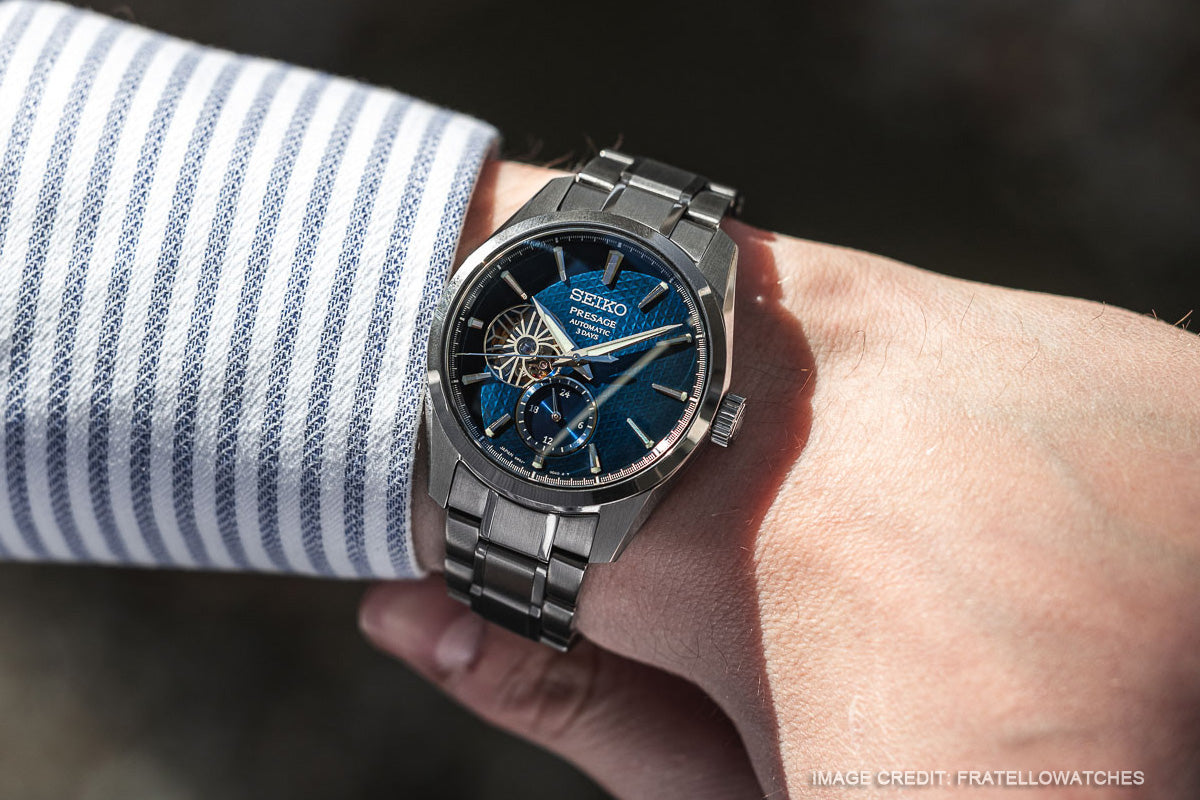Menu
-
-
Watch Bands for SEIKO
-
Customized Watch Bands
-
STRAIGHT Watch Bands
-
-
Quick Release
-
Accessories
-
Shop By
- Login

- Email Strapcode
- Strapcode on Facebook
- Strapcode on Instagram
- Strapcode on Pinterest
- Strapcode on Tumblr
- Strapcode on Twitter
- Strapcode on YouTube
How Antimagnetic Technology in Watchmaking Keeps the Precision of Time
May 04, 2023 7 min read
Magnetism is a fundamental force of nature that arises from the motion of charged particles, such as electrons. It is a property exhibited by certain materials, such as iron, nickel, and cobalt, which can be magnetized and attract or repel other magnetic materials. The Earth itself is a giant magnet, with its magnetic field generated by the motion of molten iron in its core.
Magnetic fields can interfere with the operation of mechanical watches by affecting the balance spring, which is responsible for regulating the movement of the watch's gears. When the balance spring is exposed to a magnetic field, it can become magnetized and stick to the watch's metal components, causing the watch to run fast or slow. In extreme cases, the watch can stop altogether.
To combat this problem, watchmakers have developed anti-magnetic watches that are designed to resist magnetic fields. These watches use non-magnetic materials for their moving parts or house the entire movement in a case made of a highly permeable material. The most common non-magnetic materials used in watchmaking which are alloys that are chosen for their resistance to magnetism and has a very low coefficient of thermal expansion, making it an ideal material for watch parts that need to maintain their shape and accuracy over a wide range of temperatures.

Omega tested a Seamaster Aqua Terra prototype to an insane magnetic field of 160,000 Gauss, which it survived, and it is now showcased at the Omega Museum as part of their anti-magnetic watchmaking exhibit.
The international standard ISO 764 Horology - Magnetic resistant watches defines the resistance of watches to magnetic fields. According to ISO 764 or its equivalent DIN 8309 (Deutsches Institut für Normung - German Institute for Standardization) a watch must resist exposure to a direct current magnetic field of 4800 A/m. The watch must keep its accuracy to ±30 seconds/day as measured before the test in order to be acknowledged as a magnetic-resistant watch. Annex A of ISO 764 deals with watches designated as magnetic resistant with an additional indication of intensity of a magnetic field exceeding 4800 A/m. Some watches, such as the Grand Seiko Hi-Beat 36000 Professional 600m Diver's watch, are designed to withstand even higher magnetic fields, up to 16,000 A/m or more.
Anti-magnetic Watch History
The history of anti-magnetic watches dates back to 1846, when watchmakers from Vacheron Constantin started experimenting with anti-magnetic features. However, it wasn't until several decades later that they successfully assembled the first anti-magnetic watch. The watch's non-magnetic parts, such as the palladium-made balance wheel, balance spring, and lever shaft, enabled it to withstand magnetic fields. In 1896, Charles Édouard Guillaume discovered Invar, a nickel-based alloy that contributed to the creation of anti-magnetic watches. He later developed Elinvar, another alloy that can resist magnetic fields, and received the Nobel Prize in Physics in 1920. The first anti-magnetic pocket watch was made by Vacheron Constantin in 1915, and Tissot produced the first non-magnetic wristwatch in 1930.

Tissot promotion graphic highlighting their first non-magnetic wristwatch in 1930
There are two main methods to construct a watch that is resistant to magnetic interference. The first approach involves using alloys for the moving parts that are insensitive to magnetic fields, low coefficient of thermal expansion, such as Invar (iron–nickel–carbon–chromium alloy), Glucydur (beryllium–bronze alloy), Nivarox (iron–nickel–chromium–titanium–beryllium alloy), and Elinvar (nickel-iron-chromium alloy). The second method involves enclosing the entire movement in a case made of a highly permeable material that conducts magnetism. A soft-iron clasp is placed over the movement to prevent magnetic fields from forming within the watch.
Anti-magnetic watches have been popular with people who work with strong magnetic fields since they were introduced. They are common among electronic engineers and other professionals who are regularly exposed to strong magnetic fields. Today, divers' watches must also be anti-magnetic in addition to being water-resistant, luminous, shock-resistant, and having solid watch bands, as per ISO 6425 standards.
Pioneer Watch Brands Are Known For Their Anti-Magnetic Capabilities
It's likely that different watch brands use the units they are familiar with to measure magnetic fields based on their specific applications and requirements. However, it's important to know the basic units and be able to convert between them. When measuring magnetic fields, several units are commonly used, including gauss (G), tesla (T), and ampere per meter (A/m), and the choice of unit depends on the required level of precision and specific application. Fortunately, there are conversion formulas available for converting magnetic field strength between these units. For example
- 1 A/m = 0.01257 gauss (G)
- 1 gauss (G) = 0.0001 tesla (T)
- 1 tesla (T) = 10,000 gauss (G)

IWC Ingenieur Reference 3508 has a magnetic resistance of over 500,000 A/m.
Numerous watch-making brands have utilized alloys for assembling anti-magnetic watches to improve the performance of such timepieces. IWC was one of the first watch brands to produce watches that were highly resistant to magnetic fields. The Ingenieur Reference 3508, which was produced from 1989 to 1992, was a notable example of this, as it was the first wristwatch to achieve a magnetic resistance of over 500,000 A/m. The watch's 34mm steel case incorporated a soft iron Faraday cage and a beryllium/nobium hairspring, which was a groundbreaking development at the time. The Ingenieur Reference 3508 paved the way for the development of even more advanced anti-magnetic watches, and IWC continues to be a leader in this field today.
Omega Anti-Magnetic Seamaster announced in 2013, with the Seamaster Aqua Terra model capable of withstanding up to 15,000 Gauss (1,193,663 A/m), image shown the SPECTRE version in 2015 paired with a Brushed and Polished Asteroid Stainless Steel bracelet.
The Omega Anti-Magnetic Seamaster was announced on January 17, 2013, with the Seamaster Aqua Terra model being able to withstand up to 15,000 Gauss (1,193,663 A/m). According to the press release, the watch's movement doesn't rely on a protective container inside the watch case but on selected non-ferrous materials used in the movement itself. In testing, the Omega prototype was exposed to 1.5 Tesla (15,000 Gauss) and continued to perform accurately, with no impact on its precision.

Sinn EZM 3, the anti-magnetic watch with a resistance of 80,000 A/m, also featurs the Ar-Dehumidifying Technology.
The diving watch Sinn "Einsatzzeitmesser 3" (EZM 3) is another excellent example of an anti-magnetic mechanical diving watch designed for use in extreme environments where electronic interference or power supply failure could pose a risk to quartz watches. The watch features advanced anti-magnetic technology, including a solid soft iron sheath around the movement that can protect its accuracy up to 80,000 A/m. Additionally, the EZM 3 incorporates Sinn's Ar-Dehumidifying Technology, which fills the case with protective gas to ensure optimal start conditions and includes an integrated drying capsule to absorb humidity. With carefully selected materials and double O-rings on the screwable crown, the EZM 3 is approved for diving depths up to 500 meters (50 bar pressure).

The Grand Seiko Hi-Beat 36000 Professional 600m Diver's Limited Edition (SBGH257) has an iron dial that provides magnetic resistance of up to 16,000 A/m, protecting the movement against the harmful effects of magnetism.
Grand Seiko and Seiko are both committed to producing watches that are resistant to magnetic fields, although Grand Seiko generally employs more advanced materials and techniques to achieve this goal. Grand Seiko uses unique alloys like Spron 610 in the balance spring of the watch, which is highly resistant to magnetism and at least 3 times more resistant to magnetism than conventional materials. The brand also incorporates a magnetic shield into the design of the watch, which further protects the movement from external magnetic fields. Furthermore, Grand Seiko puts its watches through rigorous testing to ensure they are resistant to magnetic fields of up to 16,000 A/m, which is well beyond the levels encountered in everyday life.
![The Grand Seiko SBGR311 Limited Edition has 4,800 A/m [60 Gauss] magnetic resistance, by Strapcode watch bands](https://cdn.shopify.com/s/files/1/0022/9792/1591/files/7-strapcode-watch-bands-W_21P18BBU63C1C43_GrandSeiko-SBGR311.jpg?v=1683169174)
The Grand Seiko SBGR311 Limited Edition has 4,800 A/m [60 Gauss] magnetic resistance, paired with a Horween Chromexcel Watch Strap
Making the Grand Seiko SBGR311 reliable and accurate in most everyday environments, paired with a Milanese Mesh Watch Band
In contrast, Seiko generally uses less advanced materials and techniques in their watches but still offers models with magnetic resistance of up to 4,800 A/m, which is sufficient for most everyday situations. Seiko use its proprietary alloy named "Spron" and Diashock technology in their movements to protect them from shocks and magnetic interference.

Seiko Presage Sharp Edged Series 3 days of power reserve SPB417 automatic watch, magnetic resistance of up to 4,800 A/m
How To Remove Magnetic Influence From Watches
Watches are precision instruments that rely on the precise movement of delicate components to keep accurate time. However, exposure to magnetic fields can disrupt the operation of a watch, causing it to run fast or slow. Fortunately, there are several methods for removing magnetic influence from a watch and restoring its accuracy.
One way to remove magnetic influence from a watch is to use a demagnetizer. A demagnetizer generates a strong alternating magnetic field that neutralizes residual magnetization in the watch's components. This process is simple and effective, and many watchmakers and repair shops offer demagnetization services.
Another approach is to have the watch serviced by a professional watchmaker. The watchmaker can disassemble the movement, clean the parts, and reassemble them in a demagnetized state. This process may be necessary if the watch has been exposed to a particularly strong magnetic field or if the demagnetization process is not effective.
Prevention is also a key to protecting a watch from magnetic fields. Avoid exposing your watch to strong magnetic fields, such as those generated by speakers, refrigerators, and magnetic clasps, as much as possible. If you must be in close proximity to strong magnetic fields, consider removing your watch or shielding it with a magnetic shield.

Everyday magnetic products that can potentially impact watches, such as A/C adapters, cell phones, speakers, and kitchen appliances
In conclusion, if your watch has been exposed to a magnetic field and is running inaccurately, there are several methods for removing the magnetic influence and restoring its accuracy. Whether you choose to use a demagnetizer or have your watch serviced by a professional, it is important to take steps to protect your watch from magnetic fields in the future.
Written by Vienna C., images by Toni and others as noted
External references
- Unit of Magnetic Field
- Grand Seiko Tough Quartz SBGX341 and SBGX343
- Seiko Presage Sharp Edged Series
- Examples of common magnetic products that may affect watches
- Magnetic Field Protection by Sinn watches
- OMEGA Tested a Prototype Seamaster At An Insane 160,000 Gauss Magnetic Field
- Omega announces the first truly anti-magnetic watch movement
Leave a comment
Comments will be approved before showing up.
Also in Watch Movements and parts

Which Watch Luminous Material Shines the Brightest in the Dark?
June 06, 2023 6 min read 1 Comment
Read MoreBe the first to know
Sign up to get the latest on Sales | New Releases & more …




